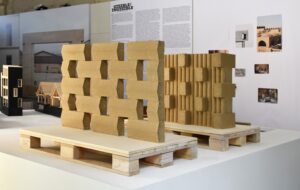|
|
||
|
When is a retrospective not a retrospective? When it is curated, not by the subject but by a Belgian, non-hierarchical art collective. OK, that’s not very funny but Progress, OMA’s sprawling, paper-strewn show at the Barbican, is. It sounds like a tag line from a communist propaganda poster. Who else would have employed such a resolutely modernist title? Koolhaas never does anything quite in the way you think an architect should. He seems to hate, with venom, a lot of things and one of them is the idea of a retrospective. When he says the word, he spits it out. So, when he was approached to do one, the question was how to do one and simultaneously avoid it. The answer, in a brilliant piece of polemical doublethink, was to have the curators of the Belgian pavilion at the 2010 Venice Biennale do the show, thus abdicating responsibility for any retrospectivity that might accidentally creep in. ROTOR, the Brussels-based collective, was given a free hand to pick what it wanted from OMA’s archives, from the detritus of everyday production and from the odd collection of – occasionally megalomaniac, occasionally brilliant – structures OMA erects. On show at the Barbican, it is a mess of production – a chaotic, sprawling show with no attempt at chronology and only an amateurish attempt at imposing any thematic coherence. It is the perfect response. OMA’s oeuvre, spread between the massive output of its building arm and its conceptual/think-tank arm AMO, is impossible to refine into a visually coherent architecture show. Recent retrospectives of John Pawson and David Chipperfield at the Design Museum – both of which were effectively self-curated – demonstrate the difficulty of the autohagiography. Stuffed with perfect models of perfect buildings, they do show something of the approach, but embody the kind of self-image that usually goes into a monograph. OMA has always been cuter in its production of books, which have never been overtly – only ever tangentially – about its own work. The Barbican show is closer in spirit to those publications, which invariably list a long series of collaborators, contributors and correspondents and have a knack of capturing a particular moment. Covering Shopping, Bigness, China, the Gulf, now even Metabolism in its latest publication “Project Japan” – its books have always been about bigger issues than its own work. But it is also easy to forget that Rem, famed as much for his writing and his dry, incisive, deadpan observations, loves architecture. Listen to him speak about Russian constructivism or about modernist architecture in the City in the 1960s and you realise that he is very far from the rootless cynic he is often portrayed as. “Every architect,” he is quoted as saying in the press release, “carries the utopian gene.” This enjoyment (which is not a word you necessarily associate with OMA or, indeed, architecture at all) comes out here, as the process is laid bare. There are mistakes, misconceptions, unfinished reports, lost competitions and hubristic failures, but there is also an endlessly inventive array of experiments, inventions and re-presentations. Then there are the screenshots of a presentation by the financial director, grumpy notes from Rem and Reinier de Graaf and a report on Lagos, opened on one of its back pages, a lot of which was left empty to make the document look fatter and more serious than it actually was. There are also 3.5 million images from OMA’s server whizzing through on a dizzying 48-hour loop, their version of Christian Marclay’s Clock. ROTOR has not exactly edited; rather, it has turned the endless stream of paper and models being spewed out of the OMA machine into a collection of found objects. The Barbican itself becomes an exhibit, as a new entrance is opened up and exploited, completely transforming the way you use the galleries. It proves to be the perfect venue, a dark, concrete utopia, a megastructure with a scale ideally suited to OMA’s ambition and profound attachment to what it seems to see as an ongoing modernist project. OMA/Progress, Barbican Art Gallery. Until 19 February 2012 |
Image Lyndon Douglas, Courtesy of Barbican Art Gallery
Words Edwin Heathcote |
|
|
||


















